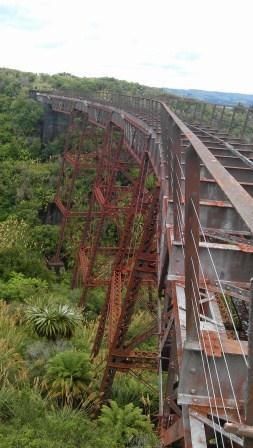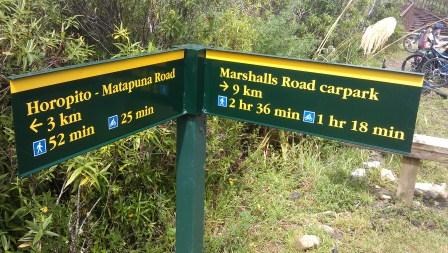IMPORTANT NOTE: It is important the cache goes back against the small tree, covered in some leaves - do not put it low down by the rock, it will fill up with water.

When completed in 1907 the Taonui Viaduct was the first viaduct finished in the last stage of the NIMT's 'final push' to get the main trunk completed, but now is bypassed, and unused. The larger and better-known viaduct, the Hapuawhenua to the south has also been bypassed, but that example has been restored to allow visitors to cross and enjoy the massive construction.
The Taunui Viaduct now awaits your visit, looking a little forlorn as the red/brown tones of lichen and surface rust slowly colour the steel. With no deck, visitors are unable to appreciate the massive size of this structure which is 140m long and 35m high.

Historic Places Trust has granted the structure a Category 1 classification, ensuring its preservation for future generations to gaze on. The longevity of this outstanding structure can be attributed to the exceptional technical skill and competence of those involved in designing, manufacturing the fabric for, and constructing the Taonui Viaduct. Look over the steelwork – no welding, all riveted – and imagine the effort needed in this extremely remote wilderness spot to erect the structure. Look harder at the spider-like structure, and you will see some short, bolted brackets at stress points - these are the materials of the sole strengthening work carried out on this bridge, from its birth to 1986 when it was retired, a further testament to the robust original design, as trains doubled in axle weights during its life.

The cache is a 400ml sistema box, camoed in brown. It is nearby the viewing point, but probably far enough away for you to grab while the muggles stare at the structure. Please do be careful, and hide it well.
To get here, we would recommend you walk or cycle the famous “Old Coach Road” from Ohakune or Horopito (around 21km total) or for a quick look, you can walk or cycle in from the Horopito end.
A parking waypoint is included for the official car-park, but if you would prefer a shorter walk, the first section of the Old Coach Road is open for driving, although grassy, an easy drive. The point you must park is shown as the trailhead waypoint.
If you enjoy this Viaduct, make sure you do have a look at the Hapuawhenua Viaduct, where GC23XB1 awaits you. On the way in from Ohakuni you will pass three other caches.
If you are curious about the point that the main trunk railway was joined, check out GC1MTBF

This is a good family walk from the Horopito end, but do watch the kiddies on the one crossing of the real railway on your way in, and there is a significant drop at the viaduct, behind a low rail.
Logging Recommendations
This cache, (like most of Radionut50’s hides) is NOT meant to be hard to find – so logs saying ‘easy find’ are pretty meaningless. The reason for this hide is to introduce you to this piece of our country’s great history , so logs commenting on your experience are very welcome. You are also invited to crack the hint as you arrive, to reduce the chance of a prolonged search compromising the hide in this very public place.